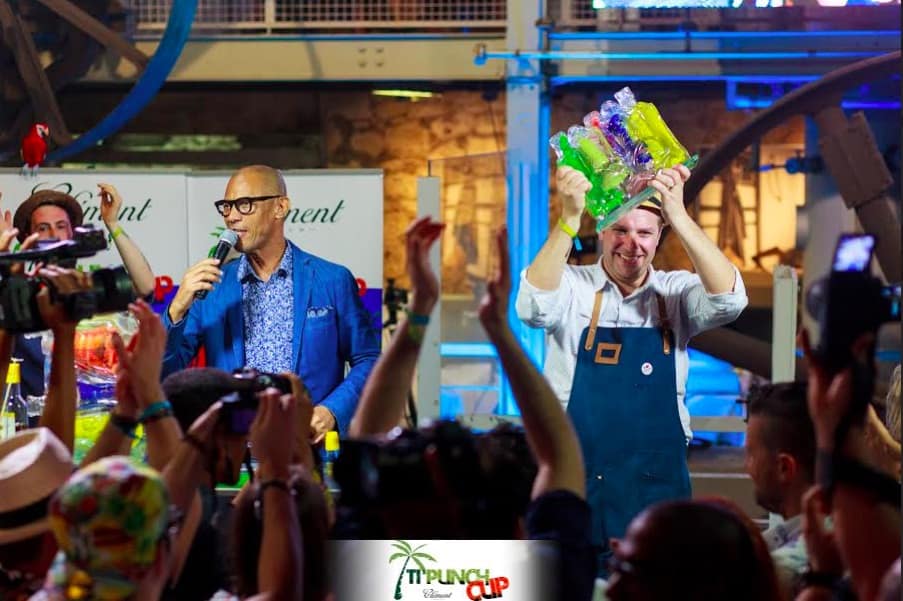I looked at my boarding pass to make sure it was correct. Terminal 1 out of JFK.
I’ve lived in NYC for 10 years and this was my first time walking through the terminal that’s the first stop off the Airtrain. Finding Norwegian Air took a few minutes (they currently only have a few kiosks and not a lot of signage). But at around $169 RT they are the first airline to offer non stop service from NYC, Boston, and BWI to the French Caribbean island Martinique. And thanks to the Martinique Promotion Bureau, The Knockturnal was on our way to the Isle of Flowers for 5 days of sun, beach, and a whole lot of Rhum.
The Knockturnal attended the inaugural Ti Punch Cup – a Rhum festival that celebrates the old traditions of Ti Punch with the new and modern trend of craft cocktails. So what is Ti Punch? Made from 3 ingredients: Rhum Agricole (white, gold or aged rhum), Sugarcane syrup, and a piece of lime Ti Punch tastes just about as strong as it sounds.
Not to be confused with the rum Jack Sparrow sang about in Pirates of the Caribbean, Rhum Agricole is the French term for cane juice rum – a style of rum distilled only in Martinique and made from freshly squeezed sugar cane juice rather than molasses, which is typical of other rums.
But its not just the production of Rhum Agricole that is so fascinating. Rhum produced in Martinique is some of the best in the world. Cane juice rhums from Martinique have the “AOC Martinique Rhum Agricole” label aka “Appellation d’Origine Contrôlée” a classification known for the best wines and cheeses in France. And if the French say its good.. well, you know its really good.
Held at the 18th century Habitation Clement Distillery and estate, the Ti Punch Cup brought mixologists from all over the world down to Martinique to battle it out for the best Ti Punch cocktail. 10 finalists had 10 minutes to “shop” for ingredients from the improved market and create their unique cocktail for the panel of 4 judges to taste. At the same time as the competition, the party ensued around the plantation’s estate. Guests sipped on Ti Punch cocktails, mingled in true French chic fashion, and indulged on appetizers like mini baguette sandwiches of ham and cheese. Dirk Hany from Switzerland’s Widder Bar was announced the Ti Punch Cup winner later in the evening which is impressive because Hong Kong and America put on quite a cocktail making show. The winning recipe?
5cl Clément Canne Bleue
2cl Clément Creole Shrubb
1cl Sugarcane Syrup
2cl fresh lime juice
2cl French Red wine
To understand how important the inaugural Ti Punch Cup was, we need to dive into the history of rhum. Martinique, which is 50 miles long and 24 miles wide, has 11 rhum distilleries left on the island – of which only 7 still produce rhum. Of course The Knockturnal toured 4 of the more famous ones including Neisson, Depaz, JM and Saint James. Neisson is the smaller family owned distillery with a boutique atmosphere and plenty of charm. We heard a rumor that a bartender from DC cocktail bar Room 11 is such a fan of Niessen rhum, he heads all the way to Martinique to get his goods. Depaz, located in the town of Saint-Pierre boasts the most stunning French chateau this side of the Atlantic and it’s history is straight out of Downton Abbey. The plantation was destroyed in the 1902 volcanic eruption of Mount Pelée – the island’s highest peak sitting just above Saint-Pierre. All but one member of the Depaz family perished in the deadly event. Victor Depaz who had been studying in France returned home years later and rebuilt his families plantation to the grandness it is today. Rumor has it he married the daughter of a nearby distillery owner to join forces in Rhum making love #swoon. JM is the only distillery to grow their own sugar cane on site and Saint James is seemingly the biggest distillery on the island complete with a train that departs from the factory and runs through the sugar cane fields.
Rhum tasting in Martinique is like wine tasting in Bordeaux and a visit to a distillery is sure to come with an instagrammable selfie in front of a botanical garden or colonial style manor. Which brings us back to the history of rhum and it’s relation to colonialism. For white Martinicans the history of rhum equals economy and richness in a new land. For black Martinicans rhum represents plantations and slavery. From either stand point, Rhum Agricole is still very much part of everyday culture and remains heavily represented in the Ti Punch.
[slideshow]

